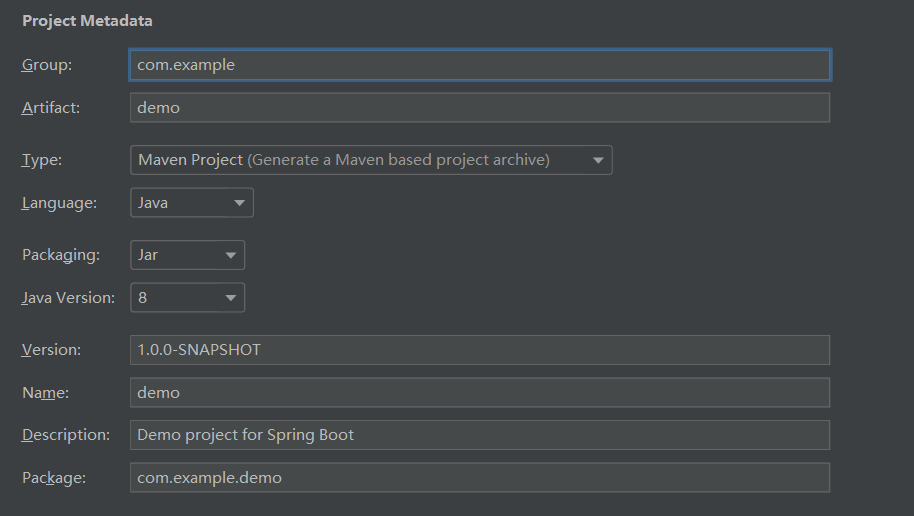不要再纠结如何计算方法执行用时了,这个东西能帮你
如果你有这样的需求:
想要计算自己的spring项目中某些方法的执行用时,且每次执行时自动输出
那么这个框架就很适合你了,目前,这个计时框架有以下优点:
- 使用简单,一行注解即可生效
- 支持高度自定义的输出格式
- 对方法无侵入
- 自由选择输出到控制台或日志
其实这个也是我自己做的小框架,完全开源,项目地址在 github-mayoi7/timer ,目前正在开发的分支是 1.x ,最新版本是 1.2.0-RELEASE
使用样例
引入依赖
首先创建一个简单的web项目

然后在 pom.xml 中引入我们项目需要的依赖:
<properties>
<java.version>1.8</java.version>
<timer.version>1.2.0-RELEASE</timer.version>
</properties>
<dependencies>
<dependency>
<groupId>org.springframework.boot</groupId>
<artifactId>spring-boot-starter-web</artifactId>
</dependency>
<!-- 计时器的依赖 -->
<dependency>
<groupId>com.github.mayoi7</groupId>
<artifactId>timer</artifactId>
<version>${timer.version}</version>
</dependency>
</dependencies>
复制代码
创建基本结构
然后接下来新建配置文件 application.yml ,不过我们这里可以什么都先不写
接着新建一个Controller,我们里面就添加一个方法:
import com.github.mayoi7.timer.anno.Timer;
import org.springframework.web.bind.annotation.RequestMapping;
import org.springframework.web.bind.annotation.RestController;
@RestController
public class DemoController {
@RequestMapping("hi")
@Timer
public void hello() {
try {
Thread.sleep(826);
} catch (Exception ignore) {}
System.out.println("Hello World...");
}
}
复制代码
这里要注意一定要把我们 com.github.mayoi7 这个包下的类扫描进来,所以可以采用以下的配置方式:
@SpringBootApplication
// 下面两种配置任选一(com.example.demo是当前项目的源码包根目录)
// @ComponentScan(basePackages = "com.*")
@ComponentScan(basePackages = {"com.example.demo.*", "com.github.mayoi7.*"})
public class DemoApplication {
public static void main(String[] args) {
SpringApplication.run(DemoApplication.class, args);
}
}
复制代码
使用注解添加计时器
好了,然后就到了重头戏,如何给这个方法计时呢?既然我们引入了依赖,这里直接一个注解就够了:
import com.github.mayoi7.timer.anno.Timer;
import org.springframework.web.bind.annotation.RequestMapping;
import org.springframework.web.bind.annotation.RestController;
@RestController
public class DemoController {
@RequestMapping("hi")
@Timer
public void hello() {
try {
Thread.sleep(826);
} catch (Exception ignore) {}
System.out.println("Hello World...");
}
}
复制代码
测试
我们启动服务器,访问 localhost:8080/hi ,会发现控制台会打印出结果:
Hello World... [(date=2019-06-08 22:22:31, name=825608c3, duration=830 ms, classInfo=com.example.demo.controller.DemoController, methodInfo=hello)] 复制代码
我们来用JMeter测试下并发下的表现,这里同时开了1000个线程循环1000次(电脑比较渣,之前开了太多被卡死机了),这里截取了一小段输出:
[(date=2019-06-08 22:36:08, name=0753f926, duration=826 ms, classInfo=com.example.demo.controller.DemoController, methodInfo=hello)] [(date=2019-06-08 22:36:08, name=a0a242cd, duration=826 ms, classInfo=com.example.demo.controller.DemoController, methodInfo=hello)] Hello World... [(date=2019-06-08 22:36:08, name=96b67174, duration=827 ms, classInfo=com.example.demo.controller.DemoController, methodInfo=hello)] Hello World... Hello World... [(date=2019-06-08 22:36:08, name=26676684, duration=827 ms, classInfo=com.example.demo.controller.DemoController, methodInfo=hello)] [(date=2019-06-08 22:36:08, name=fc283e48, duration=827 ms, classInfo=com.example.demo.controller.DemoController, methodInfo=hello)] 复制代码
可以发现虽然输出的结果还是准确的
使用教程
输出属性含义
目前可供输出的有5个属性,即刚才输出的那些:
- date :方法执行完毕的时间,也是结果输出的时间
- name :计时器名称,可以自行设置,如果没有设置则会使用一个随机8位字符串
- duration :方法执行用时
- classInfo :方法所在类的信息
- methodInfo :方法信息
这些属性大部分都可以在有限基础上自行修改,至于如何自定义我们接下来会进行讲解
配置项
配置项可以分为配置文件中的配置,和注解上的配置,我们分开来讲
配置文件
配置文件中以 timer 为前缀的是我们计时器的配置项,有两大类, timer.format 和 timer.mode ,我们单独来说
timer.format该类配置是用于配置输出格式,自由度较高,所以统一放在一起,包含有:
-
timer.format.fileFormat:日志文件名,包含了文件后缀(如果不输出到日志则无效) -
timer.format.logPath:日志输出的绝对路径,即“/”为当前磁盘根目录(如果不输出到日志则无效) -
timer.format.dateFormat:日期输出格式,形如“yyyy-MM-dd HH:mm:ss”,和SimpleFormat一致 -
timer.format.formatterPath:自定义格式化器类的全路径(待会讲到了会说)
timer.mode该类配置是用于一些既定输出模式的选择,均为枚举类型,所以统一放在一起,包含有:
-
timer.mode.timeMode:时间输出方式,目前仅有simple一种格式 -
timer.mode.unit:时间单位,可选范围为TimeUnit的所有枚举类 -
timer.mode.methodMode:方法名输出方式,有simple和param两种方式,分别是仅输出方法名,以及输出方法名和参数 -
timer.mode.classMode:类名输出方式,有full和simple两种方式,分别是类全路径输出,以及仅输出简单类名
以下是一份样例配置文件(暂时没有配置自定义格式化器):
timer:
format:
file-format: timer-demo.log
log-path: /
date-format: yyyy-MM-dd HH:mm:ss
mode:
time-mode: simple
unit: milliseconds
method-mode: param
class-mode: full
复制代码
注解配置
@Timer 注解中,目前有效的配置有以下几个:
- name:计时器的名称,如果不设置,则会默认使用随机生成的8位字符串
- unit:时间单位,默认为毫秒,在这里配置的优先级会高于配置文件
- formatter:自定义的格式化器类路径,优先级高于配置文件
- position:结果输出的位置,可选项有
ResultPosition.CONSOLE和ResultPosition.LOG,默认输出到控制台
样例配置如下:
@Timer(name = "timer1", unit = TimeUnit.SECONDS, position = ResultPosition.LOG) 复制代码
定制
如果刚才的这些配置不能够满足你的需要,这里还提供了高自由度的自定义配置
自定义输出格式
默认的输出格式不好看?没关系,现在教你如何自定义输出的格式
首先,我们在创建一个timer包,然后在包下建一个类,就叫 MyFormatter ,然后继承 AbstractFormatter ,注意千万不要引错包:
import com.github.mayoi7.timer.format.AbstractFormatter;
import com.github.mayoi7.timer.props.TimerOutputSource;
import com.github.mayoi7.timer.props.TimerProperties;
public class MyFormatter extends AbstractFormatter {
public MyFormatter(TimerProperties properties, TimerOutputSource source) {
super(properties, source);
}
}
复制代码
这里构造函数里两个对象我先说明一下, properties 是我们所设置的各项配置, source 是我们计时器的输出结果,不过这些都不用我们手动设置
然后我们在这个类中定义一个 MyRecevier 的内部类,用于获取到输出属性,需要覆写其中的 output() 方法,并在我们自定义的 MyFormatter 格式化器类中重写 getInfoReceiver() 方法,返回我们的 MyReceiver 对象:
import com.github.mayoi7.timer.format.AbstractFormatter;
import com.github.mayoi7.timer.props.TimerOutputSource;
import com.github.mayoi7.timer.props.TimerProperties;
public class MyFormatter extends AbstractFormatter {
public MyFormatter(TimerProperties properties, TimerOutputSource source) {
super(properties, source);
}
private static class MyReceiver extends InfoReceiver {
@Override
public String output() {
return "/n[myFormatter]" + date + "-" + duration;
}
}
@Override
public InfoReceiver getInfoReceiver() {
return new MyReceiver();
}
}
复制代码
在 output() 方法中,可供使用的属性有以下5个(从 InfoReceiver 中得知):
class InfoReceiver {
/** 日期 */
protected String date;
/** 名称 */
protected String name;
/** 执行时间 */
protected String duration;
/** 类信息 */
protected String classInfo;
/** 方法信息 */
protected String methodInfo;
// ...
}
复制代码
最后,最重要的一步来了,把 MyFormatter 类的路径通知给计时器,有配置文件和注解配置两种方式,我这里就在注解中配置了:
@Timer(formatter = "com.example.demo.timer.MyFormatter") 复制代码
然后运行测试,会发现输出的结果改为我们配置的格式了:
Hello World... [myFormatter]2019-06-08 23:34:20-828 ms 复制代码
获取更多的信息
当然,仅仅改个格式还不够,如果你想获取更多的关于被计时方法和其所在类的信息,我们也提供了自定义的手段
如果你想在类信息输出的 FULL 模式下获取更多的内容,我们就需要回到 MyFormatter 类中,再次添加一个内部类 MyClassFormatter ,并继承 ClassFormatter ,选择性覆写其中的方法:
import com.github.mayoi7.timer.format.AbstractFormatter;
import com.github.mayoi7.timer.props.TimerOutputSource;
import com.github.mayoi7.timer.props.TimerProperties;
public class MyFormatter extends AbstractFormatter {
// ...
private static class MyClassFormatter extend ClassFormatter {
@Override
public String formatInFull(Class clazz) {
return clazz.getName() + "-" + clazz.getTypeName();
}
}
}
复制代码
然后最重要的一点是,将这个新声明的类在构造方法中赋予对应的属性:
public class MyFormatter extends AbstractFormatter {
public MyFormatter(TimerProperties properties, TimerOutputSource source) {
// ...
classFormatter = new MyClassFormatter();
}
复制代码
同样地,我们也为方法信息提供了对应的 MethodFormatter 类和 methodFormatter 属性,使用方法基本一致,不再进行演示
到此,配置已经完成,如果我们开启了类信息输出的 FULL 模式,则刚才的 MyReceiver 中的 classInfo 属性就为我们修改后的属性了,具体内容不再测试了,感兴趣的可以自行实验











![[HBLOG]公众号](http://www.liuhaihua.cn/img/qrcode_gzh.jpg)

